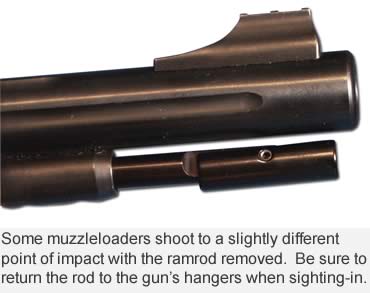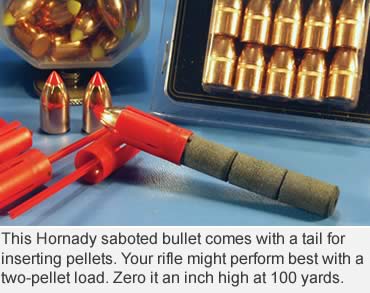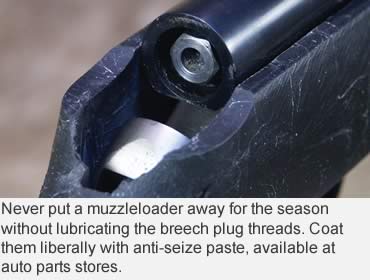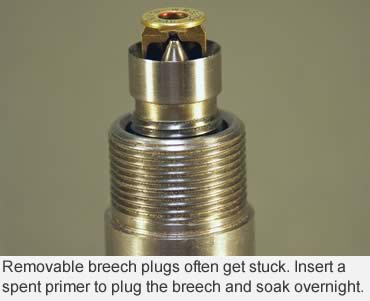By Ralph M. Lermayer
Photo: To protect a scope from corrosive blowback, wrap electrical tape around the area just above the breech.
To the uninitiated, muzzleloaders are veiled in a cloak of mystery. To hunters who understand them, blackpowder rifles are simple and predictable in operation.
What they are NOT is forgiving. Pay attention to the rules, and they will never let you down. Ignore them, and they’ll quit you like a politician’s promise.
Here are some tips to keep your frontstuffers shooting.
Sidelocks
Most sidelocks were designed to ignite with small No. 11 percussion caps. To up the performance and reliability, unscrew the nipple and replace it with one that will accept bigger, hotter musket caps or 209 shotgun primers. Check the Dixie Gun Works catalog or website to get the right thread replacement nipple for your rifle. This one step will stop most sidelock misfires, and costs under $10.
Inlines
Most blackpowder hunters use a modern, fast-twist inline muzzleloader. Keep them purring with these tips:
 Breechplugs
Breechplugs
Removable breechplugs allow thorough and easy cleaning. The problem is, they don’t always cooperate. They become stuck, sometimes impossible to get out. When the rifle is new, go over the breechplug threads with fine emery cloth to smooth them and remove all burrs.
Stainless is notorious for burrs. Coat the plug threads liberally with anti-seize paste available at auto parts stores. Remove, clean and recoat the threads after every 20 to 30 shots. Never put the gun up for the season without treating the breechplug threads.
To remove a really stuck breechplug, put a spent cap over the nipple, hammer down on the cap, and set the rifle muzzle-up on a newspaper in the garage (it will leak). Then put an inch or two of penetrating oil down the bore and leave it overnight. The breechplug should break loose by morning.
 Foul the Bore
Foul the Bore
The first shot from a squeaky clean, freshly oiled bore can be way off from where you zeroed the rifle. Always fire a fouling shot (squib or light load) to get back to zero before the hunt. It need not be a full charge. Use a half load and a cheap bullet.
Scope Crud
If your inline is scoped, as most are today, be sure to protect it from corrosive fouling from the gun’s breech area. Powder residue that winds up under the scope body will eat away the finish.
Cover this area to protect it. Some commercial scope covers will solve this, but a simple fix is to wrap the area with common electrical tape or camo tape and just leave it in place.
 Ramrods Influence Harmonics
Ramrods Influence Harmonics
Make sure your ramrod is in the rifle’s hangers for every shot. Many rifles will shoot to a different point of impact with the ramrod removed. In the hangers is where it will be when you take the shot, so make sure that’s where it is when you’re sighting-in, not on the bench.
Sight-in Right
The average inline hunting load is about 100 grains of powder over a bullet weighing from 295 to 325 grains. Set that load to strike about an inch high at 100 yards, and it should be point-and-shoot accurate from 20 to about 125 yards.
Beyond that, learn where your bullet strikes, and tape a drop chart to the stock of your gun for quick reference.
Putting the Gun to Bed
Does your muzzleloader need to be emptied every night? Mine don’t, but I live and usually hunt in a dry area. If the weather is damp, I shoot out the load each evening and load a fresh one in the morning.
I’ve left my gun loaded for an entire two-week blackpowder hunting season. It all depends on the humidity level. When in doubt, shoot it out.
 Have a Witness
Have a Witness
Sooner or later, you’re going to wonder if you forgot to load powder, if you dropped one or two pellets downbore, or if you loaded two bullets instead of one or any bullet at all. How can you know?
The solution is a witness mark on your ramrod. With the proper load downbore, see how far out of the muzzle the rod sticks out, then mark it with a scratch, paint or tape. A witness mark will save you a ton of grief. A quick glance will tell you if your load is right or if there’s a problem.
Read Recent GunHunter Articles:
• Bear Bait: My right leg throbbed with every step as I plowed through the knee-deep snow...
• Going Full Bore: They may not be as accurate or flat-shooting as saboted slugs, but wide-bodied slugs continue to dominate the slug market.
This article first appeared in the August 2011 issue of Buckmasters GunHunter Magazine. Subscribe today to have GunHunter delivered to your home.